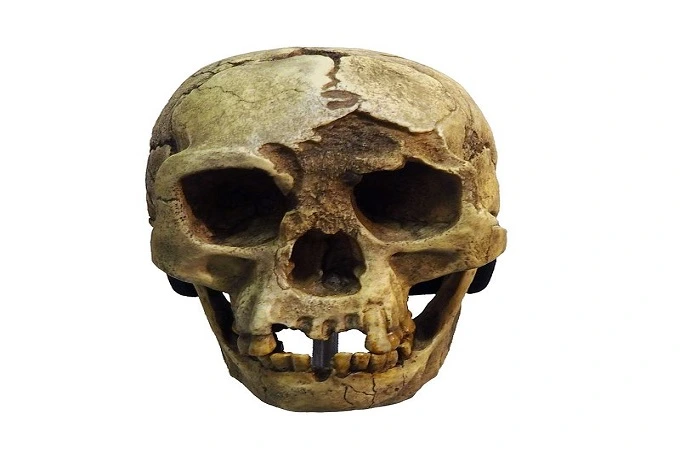The mysterious man from the island of Flores

In the cave of Liang Bua on the Indonesian island of Flores, a strange type of hominin (early man) was found in 2003. Although he was given the scientific name Homo floresiensis, he became known as “hobbit.”
There was no one who resembled a ‘hobbit’ in the two million years of human development. In comparison to contemporary people, he was relatively little. The adult man was barely 1.1 meters tall and weighed only 25 pounds. It also had a small skull, which was unique. The hobbit’s brain was about the same size as a present chimp’s.
The hobbits might have lived on Flores for a hundred thousand years. They disappeared for good some 15-18 thousand years ago, yet the cause for this is as mysterious as the presence of this peculiar species. As a result, ‘hobbits’ are the most recent human species to walk the Earth alongside us.
Is this creature a different species altogether? This is a hotly debated issue among palaeoanthropologists. Some claim it’s just a dwarf version of the current man. Others believe the “hobbit’s” size, especially its small head, was caused by a hereditary condition like microcephaly or Down’s syndrome.

On the island, “Hobbits” were shut off from the rest of the world. Another element that may have helped them to develop to such a tiny size is their isolated environment. A small elephant ancestor, for example, lives on the island.
These concepts are often discussed. The form and size of the ‘hobbit’ have been studied in various ways. According to Antoine Balzeau of the French Museum of Natural History, the difficulty is that many of these statements concentrate on characteristics of the skull, which is a common variation among hominids. If a feature is normal in other fossils, it cannot be said that it is the definitive clue.
Furthermore, many studies of the hobbit have relied on casts or low-resolution scans that do not retain essential anatomical characteristics. Flores is still one of the most significant fossils found in recent years; therefore, experts want to clear up some of the confusion regarding its identity.
To do so, University of Paris scientists Antoine Balzeau and Philippe Charlier examined high-resolution pictures of the group’s lone complete member, the LB1 skull, to detect various regions of bone thickness and composition. Minor adjustments or alterations might reveal which human species the ‘hobbit’ most closely resembles. They employed scans that were 25 times more detailed than earlier research. The researchers also examined the skull’s interior to see how the bony plates are connected. However, none of these characteristics could account for the skull’s unusual morphology. Even when various diseases are taken into consideration, it does not resemble the form of a modern human skull. According to the observations, this skull does not like any known current human skull. In other words, the “hobbit” was neither a dwarf nor a sick human. It has a more exotic connotation.

The “hobbit” is distinguished from humans by the absence of a chin. And, as you may know, having a chin is a distinguishing trait of our species. There were no other hominids who had one.
According to Dr. Simon Underdown of Oxford Brookes University in the United Kingdom, there have been numerous “final words” on what the “hobbit” is.
The “hobbit” resembled upright man (another early human species presumed to be our progenitor) more than any other hominid. This supports the theory that the “hobbit” developed from a population of that prehistoric human species.
Whatever the situation may be, the discovery is strange. The eyes are tiny and have a distinct form from those of upright people. Some researchers even contend that Homo floresiensis is too primitive to be classified as a member of our genus. Some aspects of its bones resemble those of the australopithecines, an early group of big apes. As a result, the ‘hobbit’ is a near cousin of Lucy, the most renowned Australopithecine.

Doctors make up most of those who say Homo floresiensis is a contemporary human. They establish the diagnosis based on common characteristics that are associated with a certain illness or pathology. Such a comparison may be legitimate if we could identify a contemporary person with the same traits as a ‘hobbit.’ However, as far as we know, such a person does not exist.
Robert Eckhardt of Pennsylvania State University in the United States, on the other hand, thinks that this person was a contemporary person with a genetic disease. According to the latest research, the ‘hobbit’ lacks the thickness of a skull bone that would enable it to be classified as a distinct species. There is no proof that the other 11 or 12 people are abnormal.
We also have no idea what the others looked like since just one entire skull was discovered. It seems that naming a new species based on a single specimen is challenging.
The argument about the real identification of the ‘hobbit’ is likely to persist due to the several ways used to research the subject. New research, according to Chris Stringer of the Natural History Museum of London in the United Kingdom, may provide more information, but scientists cannot confirm the status of the ‘hobbit’ species at this time.




